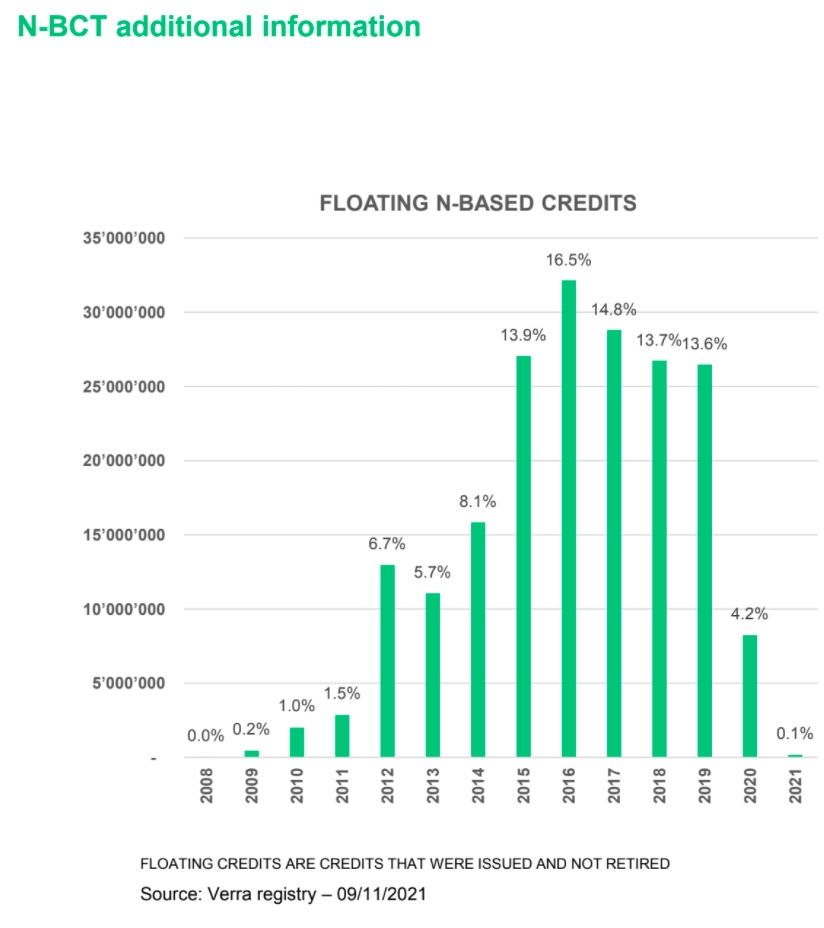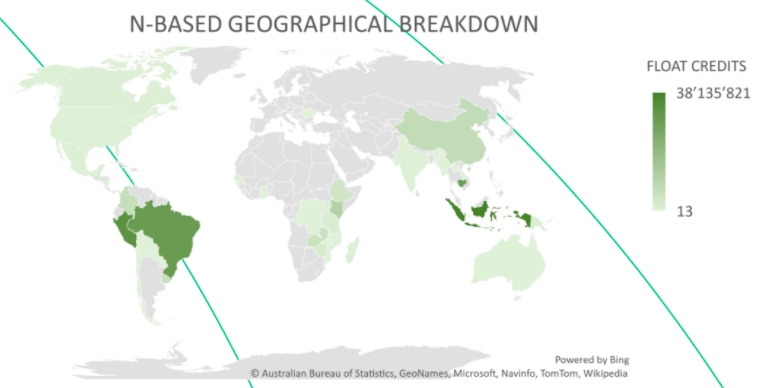NCT Pool Report
A report detailing the Nature Carbon Tonne criteria design process
Since April 2023: The rolling vintage is abandoned in favor of a minimum vintage set at 01.01.2012
NCT: Pool Party Report
This report was compiled by Sarah Baxendell of Regen Network, one of the stakeholders involved with the design of the Nature Carbon Pool.
Development Timeline: October 2021 to February 2022 Core methodology developers: Toucan, Regen Network, Moss.Earth, Joseph Pallant (Blockchain for Climate Foundation) Advisors & Stakeholders: KlimaDAO, BICOWG, StarCB
Why NCT?
Nature-based carbon credits are higher quality than non-nature-based carbon credits, because of their intrinsic benefits, including ecological co-benefits (soil quality, water quality, air quality), habitat preservation, species protection, social and economic benefits for communities who engage in carbon credits projects. These credits typically sell for market price premiums, and in more limited vintage quantities, than other forms of carbon credits. Nature is a finite resource.
The digital carbon marketplace will evolve over time, offering indexes that focus on distinct credit types, as a way of utilizing fungible strategies while honoring the uniqueness of different carbon credit types. From this, NCT was born, a fungible representation of nature-based carbon credits held in a carbon pool on the blockchain, so that price discovery for natural world solutions can be explored.
What are the inclusion criteria?
Methodologies: Nature-based carbon credits, excluding VM022
NCT*-compatible credits have clear and verified ecological benefits, positively affecting our environment from local to global scales.*
Vintages: 2012 and later, with a 10-year rolling acceptance window
The Pool Party agreed that a rolling acceptance window provided an elegant, governance-minimized way to ensure that eligible credits remain high quality. By starting with 2012, the Nature Carbon Tonne will support significant liquidity for nature based carbon.
Standards: Verra
As the largest and most widely-known carbon standard, Verra was chosen to ensure that on-chain carbon credits inherit the credibility and reputation of the VCS Program. Expanded support for additional respected registries is planned over time.
How were the inclusion criteria for NCT determined?
A series of 10 weekly meetings including participation of methodology developers, advisors and stakeholders, were held to explore the edges of the inclusion criteria, and informed the final criteria for NCT as well as launch parameters. In addition to these weekly meetings, a large number of interactions were held synchronously and asynchronously via documents, chats and video calls, to incorporate feedback from various actors to create an inclusion criteria that would best serve the on-chain carbon market.
Included and excluded methods
The NCT inclusion criteria (at launch) should align with the list of methodologies that is already accepted by the Open Climate Registry, but only include nature-based methodologies from the Verra Registry.
✅ Included Methods:
VM0003: Methodology for Improved Forest Management through Extension of Rotation Age, V1.2
VM0004: Methodology for Conservation Programs that Avoid Planned Land Use Conversion in Peat Swamp Forests, v1.0
VM0005: Methodology for Conversion of Low-productive Forest to High-productive Forest, v1.2
VM0006: Methodology for Carbon Accounting for Mosaic and Landscape-scale REDD Projects, v2.2
VM0007: REDD+ Methodology Framework (REDD-MF), v1.6
VM0009: Methodology for Avoided Ecosystem Conversion, v3.0
VM0010: Methodology for Improvement Forest Management: Conversion from Logged to Protected Forest, v1.3
VM0011: Methodology for Calculating GHG Benefits from Preventing Planned Degradation, v1.0
VM0012: Improved Forest Management in Temperate and Boreal Forests (LtPF), v1.2
VM0015: Methodology for Avoided Unplanned Deforestation, v1.1
VM0017: Adoption of Sustainable Agricultural Land Management, v1.0
VM0021: Soil Carbon Quantification Methodology, v1.0
VM0024: Methodology for Coastal Wetland Creation, v1.0
VM0026: Methodology for Sustainable Grassland Management (SGM)
VM0027: Methodology for Rewetting Drained Tropical Peatlands, v1.0
VM0029: Methodology for Avoided Forest Degradation through Fire Management, v1.0
VM0032: Methodology for Adoption for Sustainable Grasslands through Adjustment of Fire and Grazing
VM0033: Methodology for Tidal Wetland and Seagrass Restoration, v1.0
VM0034: British Columbia Forest Carbon Offset Methodology, v1.0
VM0035: Methodology for Improved Forest Management through Reduced Impact Logging, v1.0
VM0036: Methodology for Rewetting Drained Temperate Peatlands, v1.0
VM0037: Methodology for Implementation of REDD+ Activities in Landscapes Affected by Mosaic Deforestation and Degradation, v1.0
VM0042: Methodology for Improved Agricultural Land Management, v1.0
Also included: AR-AM0001, AR-AM0002, AR-AM0003, AR-AM0004, AR-AM0005, AR-AM0006, AR-AM0007, AR-AM0008, AR-AM009, AR-AM0010, AR-AM0011, AR-AM0012, AR-AM0013, AR-AM0014, AR-AMS0001, AR-AMS0002, AR-AMS0003, AR-AMS0004, AR-AMS0005, AR-AMS0006, AR-AMS0007, AR-ACM0001, AR-ACM0002, AR-ACM0003
❌ Excluded Methods:
VM0022: Quantifying N20 Emissions Reductions in Agricultural Crops through Nitrogen Fertilizer Rate Reduction, v1.1
Argument: Not necessarily a bad methodology, just not working on the same SSRs (sources, sinks and reservoirs) as projects seeking to keep or increase carbon sequestered in biogenic material.
⚠️ Projects should only utilize nature-based methodologies - ie. if a project uses both a nature-based methodology and a non-nature-based methodology for the same credit issuance, it would not qualify for NCT.
Vintage year selection
NCT utilizes a 2012 start date for vintage year requirements. The following pros/cons of start date criteria were explored in determining this vintage start date:
Selected criteria:
✅ 10-year rolling inclusion criteria, 2012 vintage start date:
Pros
Keeps the carbon high quality and hopefully the price higher, governance-minimized criteria evolution, mimics the commonly enacted progression of vintage/start date eligibility employed by offset systems.
Relatively early start date means 95%+ of nature-based credits to be eligible for the pool, enabling significant liquidity.
Cons
Excludes some vintage years of projects that also have credits for vintages 2008 - 2011.
Early start date reduces attractiveness for newer credits to enter the pool.
Rejected criteria:
❌ 2008 vintage start date:
Pros
Mirrors current BCT start dates, doesn't exclude older vintages, some projects developed at this time were great.
Cons
Some potential issues with CDM projects starting prior to 2012 regarding financial additionality, older credits could be perceived as low-quality and reduce their value as collateral.
❌ 2016 vintage start date with 10 year rolling window:
Pros
Follows CORSIA criteria, as newer vintages are included the likelihood that the prices of these credits are higher goes up.
Increases differentiation between NCT and BCT whilst allowing for over 60% of available nature-based credits to be eligible for the pool.
Cons
Excludes many vintage years of projects that also have credits for vintages 2008 -2015, reducing liquidity.
❌ 2012 vintage start date, no rolling inclusion criteria:
Pros
Reflects more closely the vintages that are available for purchase in the over-the-counter marketplaces (ie. many older vintages are sold out), as newer vintages are included the likelihood that the prices of these credits are higher goes up, Matches MOSS.earth's criteria for MCO2.
Cons
Excludes many vintage years of projects that also have credits for vintages 2008 - 2011 and early start date decreases price differentiation with $BCT and reduces attractiveness for newer credits to enter the pool.
Supporting Data


Last updated
Was this helpful?